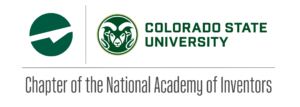
Colorado State University recently celebrated the establishment of a National Academy of Inventors chapter, capping a surge in innovation and technology transfer at the university in recent years.
“We have been kicking around the idea of starting an NAI chapter for several years,” said Sarah Hibbs-Shipp, Director of Communications for the Colorado State University Research Foundation (CSURF), the university system’s technology transfer arm. The breakthrough came in 2019 when, for the first time ever, CSU made the NAI’s annual Top 100 List of worldwide universities granted U.S. patents.
“Making the Top 100 was when we knew we were likely going to remain consistent enough in patent applications and patents issued to develop an NAI chapter at CSU,” she explained. “We had never before had enough patents issued in a single year to be recognized on that list.
Over the past decade, patents issued at CSU have increased more than fourfold, and licensing and revenue of University technology has doubled, versus the preceding decade.
CSU’s advances at work in the community
For Sue James, Vice Provost for Faculty Affairs and a recently-recognized NAI Fellow for her career achievements in mechanical, biomedical and materials science engineering, the growing focus on innovation at CSU is an important part of fulfilling the university’s land grant mission.
“Much of the work we do is funded by public monies, and the public wants to see us transfer the fruits of our scholarship to the real world,” James said. “Overall, academics are more focused on translational work than they used to be.”
Hibbs-Shipp agreed: “Filing patents and commercializing inventions are stellar examples of the function of a land-grant university. These applied innovations can be commercialized to improve quality of life and end up doing a tremendous amount of good in the public space. The growth we are seeing right now is the result of patenting activities five, ten, even 15 years ago. It is important that we use our momentum to continue the innovative success of our faculty and students.”
The benefits to the community extend beyond the direct impact of the innovations themselves. Commercialization of university research can be a regional economic engine, creating jobs and driving growth.
The inaugural meeting of the CSU NAI chapter will be held on Tuesday, February 22, 2022, from 11:30-1:00 p.m. via Zoom.
For information on how to register for the meeting or join the organization, visit the chapter’s web site.
Improving access to innovation skills
 The new NAI chapter is a student organization, but it isn’t just for students. Anyone affiliated with CSU is welcome to engage with the new chapter and learn more.
The new NAI chapter is a student organization, but it isn’t just for students. Anyone affiliated with CSU is welcome to engage with the new chapter and learn more.
Hibbs-Shipp hopes it will help CSU respond to students’ hunger for access to the knowledge and skills needed to have an impact in the world.
“Students want to learn about intellectual property and patent law,” she said. “They want more access, on a more regular basis, to these concepts. We’re hoping that many of the educational efforts originating with the technology transfer unit will shift to the NAI chapter, as a student-run organization. It will be a richer, more active experience, and provide tremendous professional development for our undergrads and graduate students, many of whom will go to work in private industry. Private industry loves it when their applicants have an understanding of intellectual property. So it’s a big resume developer.”
For James, it all dovetails nicely with her new role as Vice Provost and her own passion and success as an inventor. She hopes the new chapter will enable faculty to bring their work to bear on the problems facing the world today.
“Culture has to be cultivated and it’s not always inherent within the character of a university, even a top-tier research university. So, I am interested in increasing the culture of innovation across CSU, and helping faculty in any field who want to be more innovative and enhance the impact of their novel work on the world.”
James is especially aware of chance to increase opportunity for those who haven’t historically been well-represented among inventors and innovators.
“We want to make sure that the folks who are innovating and inventing in our CSU community are a diverse and inclusive group,” she explained. “Being innovative is a bit risky, even if you’re on a tenure track. There are theories that people with minoritized identities are less likely to take the risks involved with invention and entrepreneurship. And we really want to kind of crack that open, and figure out what’s going on there, and enable anybody who wants to be involved to do so.”